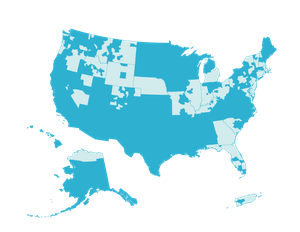The fact that much of rural America is a “child care desert” has far-reaching implications for the families, children and care providers directly affected—but also for regional and national economic health and wellbeing. In other words, it impacts all of us. LISC’s Nicole Barcliff argues for ways the next USDA Farm Bill can nurture a humane and robust child care network across rural places through dedicated funding and technical assistance. All of which demands a critical shift in perspective.
The child care crisis facing our nation—a widespread scarcity of quality, affordable options for families—may be more extreme in rural America than anywhere else. Three out of five rural parents live in “child care deserts” and must drive 10 miles or more to reach an early childhood care facility. These challenges stem from a confluence of conditions including low population density, lack of infrastructure and long distances between homes and businesses – combined with high operating costs, low worker wages, and very thin profit margins that plague rural childcare businesses.
The shortage of developmentally appropriate home- and center-based facilities is a serious obstacle to family wellbeing and economic growth in and of itself. But equally important are investments in worker compensation and subsidies for families in need. While reams of research show that physical environments directly affect the quality of child care and early learning programs, there are no dedicated, stand-alone federal resources to support the acquisition, construction or renovation of child care facilities in either rural and urban areas.
Status quo funding resources do not work for most child care programs. Many operators are "unbanked" or "underbanked" and so have trouble accessing loan capital. Most loan products, meanwhile, are not designed to meet the unique needs of the sector. To navigate funding opportunities, child care business owners need tailored technical assistance; good access to grant resources would help, too, while they work to build credit. One in four child care providers, moreover, has a hard time finding affording housing, yet few programs support housing stability or pathways to homeownership for child care workers.
Rural childcare providers also face restrictions to using certain United States Department of Agriculture (USDA) financial supports for commercial (for-profit) and home-based child care. Notably, USDA Rural Community Facilities Program funding can only be used to support non-profit child care models. But it’s privately operated, home-based providers who are overwhelmingly answering the child care needs of rural families. As it stands, too many barriers block the way to directing these and other USDA resources to improve home-based child care settings.
So, what can be done? Bringing attention to the plight of rural communities is an important part of the story. But how can we tackle the crisis and begin to eliminate the factors that brought us to this point in the first place?
For starters, public and private sector stakeholders must resist the habit of sideling child care and keeping resources in silos. Many sectors share the responsibility for alleviating child care scarcity in rural areas, and we need to consider child care resources as part and parcel of how we support communities. The federal government plays an important role in leading this charge. In fact, the 2023 Farm Bill presents an unprecedented opportunity to take two crucial steps toward better supporting home- and center-based child care programs so that states and communities can meet local needs.
First, Congress should prioritize financial and technical assistance to the child care sector across existing relevant programs in order to help improve rural child care access to financial resources. The bipartisan and bicameral Expanding Childcare in Rural America (ECRA) Act of 2023 directs USDA to prioritize child care across several of its programs and initiatives. This legislation should be incorporated when the Farm Bill is reauthorized.
Second, and in concert with the point above, Congress should establish dedicated federal resources for child care facilities and related technical assistance and capacity building. The creation of a Child Care Facilities Financing Initiative (CCFFI) at USDA, modeled after the successful Healthy Food Financing Initiative (HFFI), could meet the needs of rural communities by leveraging the expertise and resources of intermediaries. The CCFFI could help bridge critical infrastructure financing gaps child care programs face; it would support home-based, commercial and non-profit child care providers alike; and it could stabilize child care business models with technical assistance.
Rural communities are America’s ultimate caregivers, providing food, water, energy, and recreation to the rest of the country. And by and large, it is rural parents and caretakers who do the work to make that happen. As such, the rural child care crisis affects all of us. It is our collective duty to leverage the expertise and resources of multiple sectors to alleviate that crisis. Prioritizing child care across USDA programs, and integrating dedicated facilities capital into the USDA toolbox, are common-sense and actionable strategies that move us beyond talk and toward progress and wellbeing.
ABOUT THE AUTHOR
 Nicole Barcliff, Senior Policy Director
Nicole Barcliff, Senior Policy Director
With two decades of public policy experience, Nicole Elizabeth Barcliff joined LISC in November 2012. As a Senior Policy Director, she advocates for federal policies that support LISC’s mission to forge resilient and inclusive communities of opportunity across America – great places to live, work, visit, do business and raise families. Nicole works closely with LISC national programs, LISC local offices, and a broad cross-sector of organizations to develop legislation and implement policy advocacy agendas that promote access to equitable opportunity in local communities. Her priority policy areas include safety and justice, health, and child care and early learning. Prior to joining LISC, Nicole held various positions that helped shape her federal policy expertise, including serving as Legislative Director for a member of Congress in the U.S. House of Representatives, Vice President for Education Affairs at the Motion Picture Association of America (MPAA), and Senior Associate for Government Relations at the Pew Charitable Trusts.
